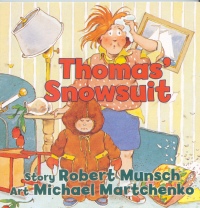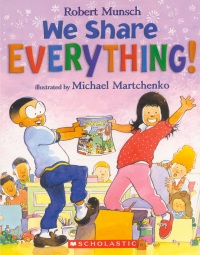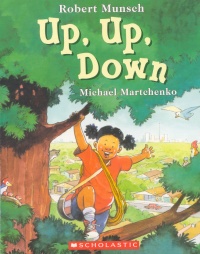| ________________
CM . . . . Volume XVIII Number 12 . . . . November 18, 2011
For over three decades, Robert Munsch has been successfully telling stories to, and writing books for, the preschool/kindergarten and early elementary school set. His stories have appeared in hardcover and paperback form, have been packaged with CDs, and have been brought out in collected volumes like Munsch More!. More recently, some of his previously published stories have been adapted and published as board books, and the resulting products vary considerable in quality. Of the three books herein reviewed, Thomas’ Snowsuit is most definitely the weakest. Most adults readers will be familiar with the plot of Thomas’ Snowsuit which originally appeared in 1985. Thomas’ mother had bought him “a nice new brown snowsuit”, but Thomas thought it was “the ugliest thing [he had] ever seen in [his] life”, and he drew his line in the sand: “If you think I’m going to wear that ugly snowsuit you are crazy.” Obviously Thomas’ mother had met her son’s assertive stubbornness before as she simply replies, “We’ll see about that.” The first child/parent test of wills comes the next day when Thomas must head off to school attired in the brown snowsuit. Most unfortunately, the board book version of the plot omits all of the aforementioned information and simply begins the story with the last two sentences of the original book’s first page of text: Instead of readers being observers at a disagreement between a parent and child over a child’s clothing choices (or lack thereof), readers now simply meet a willful, disobedient child. As readers of the 1985 book will recall, a similar “refusal” situation occurs in the school setting when Thomas’ teacher asks him to put on his snowsuit. Again, because of the omission of the mother’s antecedent purchasing behavior, Thomas’ response is not seen by board book readers as Thomas’ once more trying to assert his independence. Instead, his stubborn refusal just comes across as negative, “bratty” behaviour. In the teacher, principal and Thomas clothes interchange scenes, the board book version omits details while changing others, with one of the two most significant changes being that Thomas, at this point in the story, no longer receives his classmates’ playground invitation, “Thomas, come and play”, an invitation that leads to his voluntarily donning his snowsuit. The second, and most significant change, is that Thomas does not have any role in the principal and teacher’s getting back into their own clothes. One of the continuing features, and strengths, of Munsch’s writing is that his stories are seen to empower his young protagonists, but, in this reworked version of Thomas’ Snowsuit, Thomas has been rendered essentially impotent. The 1985 version’s ending that saw the principal quitting his job and moving to Arizona (“where nobody ever wears a snowsuit”) has been replaced by Thomas’ now simply going out to play with his friends. Michael Martchenko’s original illustrations for Thomas’ Snowsuit remain unchanged, but, because of the text changes and omissions, the illustrations don’t always “fit” quite as well. For example, in the board book’s penultimate illustration, Thomas is seen wearing his snowsuit and walking “off stage” while rubbing his hands together in that “job done/finished” gesture. Of course, in the original version, Thomas had already been outside playing and had returned to the classroom where he had picked up the teacher in one hand and the principal in the other and had gotten them back into their respective clothing. Now children are left wondering why he has his snowsuit on and looks so self-satisfied. Though Thomas’ Snowsuit (2011) bears the same title and, in the main, the same illustrations as Thomas’ Snowsuit (1985), the two volumes are definitely not the same book story-wise, and toddlers will be better served by waiting a few years and meeting the “real” Thomas. 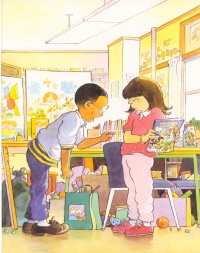
We Share Everything! (1999) and Up, Up, Down (2001) fare slightly better than Thomas’ Snowsuit, but again their weaknesses as board books can be ascribed to the many omissions of details that, in the original books, had contributed to character development and/or as explanations for the juveniles’ behaviors. Because of the intended new, younger audience, the setting of We Share Everything! has been moved from a kindergarten class in a school to a daycare, and one of Martchenko’s original opening illustrations has been cropped so that it is less apparent that the stairwell portrayed is located in a school. One of the points that the original story had tried to make was that some child behaviors that may have been “acceptable” at home are not acceptable in a kindergarten (i.e. institutional) setting. For example, when Jeremiah screams because Amanda won’t give him a book she has or when Amanda kicks down a tower of blocks that Jeremiah had created, both did so in the 1999 version of the tale because the two children had previously and successfully used these behaviors with their siblings at home in order to get what they wanted. In the board book version, Jeremiah and Amanda’s conduct is simply presented as spontaneous. Like Thomas’ Snowsuit, Up, Up, Down jumps immediately into the action without setting the stage. The 2001 version told readers that:
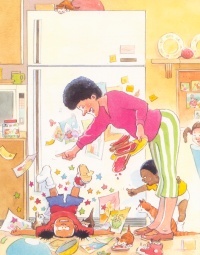
The board book begins, “Anna climbed up the refrigerator.” The omission of just the four words, “who liked to climb,” actually makes a significant difference in how readers come to perceive Anna. In the board book, after Anna falls off the dresser, her second climbing object, “Her father said, ‘Be careful! Don’t climb. Go play outside.’” In the 2011 version, “So Anna decided to go outside where it was okay to climb....” Again, the reworked story version has changed the protagonist’s motivation and degree of personal “power.” When Anna reaches the top of the tall tree that she climbs, she now just yells, “I’m the king of the castle!” whereas in 2001, this line was followed by the juvenile taunt, “Mommy’s a dirty rascal”, a challenge also later directed at Anna’s father. Though Martchenko’s illustrations for the board book version of Up, Up, Down are unchanged, the text modifications do create some dissonance between words and artwork. For instance, in 2001, Anna “got her brother and sister and they ran inside and got ten enormous Band-Aids.” Now, just Anna “got two enormous Band-Aids”; however, Martchenko’s illustration reveals three children transporting many more than two Band-Aids while two illustrations later the parents are each portrayed as being wrapped in several Band-Aids. Though the texts of both We Share Everything! and Up, Up, Down have been significantly truncated, both books are still longer and, therefore, thicker and heavier than the typical board book. From my reading about Munsch’s creative process, it is my understanding that his final texts are usually the result of his having told a story many, many times to a variety of audiences, and that he uses these opportunities to refine and hone the story’s wording so that the version that goes to print is as “perfect” as it can be and that each word, as in a poem, has a purpose. Consequently, I find that these Munsch-lite versions offer youngsters much less than the originals. Thomas’ Snowsuit - Not recommended. We Share Everything! - Recommended with reservations. Up, Up, Down - Recommended with reservations. Dave Jenkinson, CM’s editor, lives in Winnipeg, MB.
To comment
on this title or this review, send mail to cm@umanitoba.ca.
Copyright © the Manitoba Library Association. Reproduction for personal
use is permitted only if this copyright notice is maintained. Any
other reproduction is prohibited without permission.
NEXT REVIEW |
TABLE OF CONTENTS FOR THIS ISSUE
- November 18, 2011.
AUTHORS |
TITLES |
MEDIA REVIEWS |
PROFILES |
BACK ISSUES |
SEARCH |
CMARCHIVE |
HOME |
